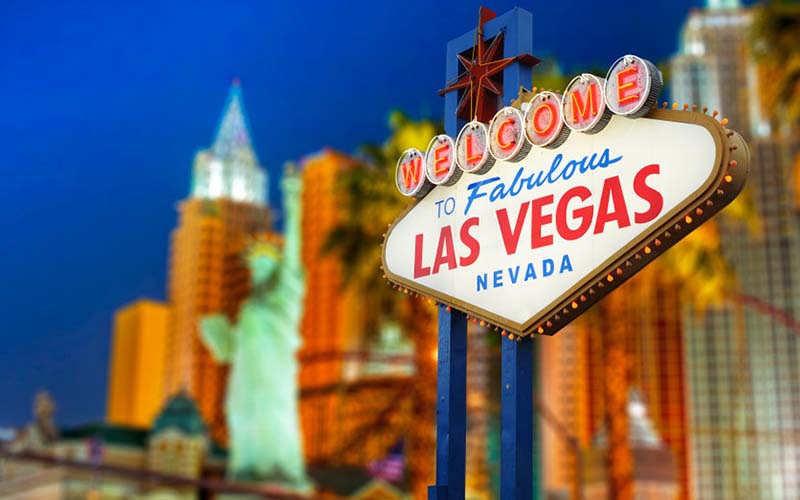Las Vegas is famously known as the gambling and entertainment capital of the world, but what does the name Las Vegas actually mean?
What does Las Vegas mean? Las Vegas is a Spanish phrase that roughly translates to “The Meadows.” The city was originally given its name in the early 1800s by a Spanish scout named Rafael Rivera.
The Meadows may seem like an odd name for a city located in the middle of a desert, but it makes more sense when you understand the backstory.

What Las Vegas Means in Spanish
Las Vegas Meaning – When translated from Spanish into English the word “Las Vegas” means “The Meadows.” It’s a rough translation using old Spanish because the phrase “Las Prados” can also mean “The Meadows” in Spanish.
If you’re wondering why it’s “Las” instead of “Los” (like Los Angeles), it’s because words in the Spanish language have a gender. It just so happens that “Vegas” is feminine in Spanish.
How Las Vegas Got its Name
Las Vegas got its name in 1829 when a Spanish explorer named Rafael Rivera became the first non-Native American to discover the area. He was part of a group of traders, led by Antonio Armijo, traveling along the Old Spanish Trail from New Mexico on their way to Los Angeles.
Rafael was part of a scouting party that separated from the main group to search for water. When he arrived in Las Vegas Valley, he came across an abundant natural spring surrounded by lush green areas. He named the place “the meadows” after the grassy oasis he found in the valley.
16 years later in 1844, John C. Fremont helped put Las Vegas on the map. He added Las Vegas to one of the early maps of the western United States, making it an important stop on the Spanish Trail while traveling to California. Fremont Street in downtown Las Vegas is actually named after him.
Las Vegas was founded as a city in 1905 when the Union Pacific Railroad auctioned off plots of land in the area. Voters then officially incorporated Las Vegas, Nevada in 1911. Development of Nevada continues to this day making it one of the fastest-growing areas of the United States.
State of the Las Vegas Springs Today
The original natural springs aren’t located too far from the casinos on the Las Vegas Strip. You can still find the Springs Preserve near downtown Las Vegas. Unfortunately, water no longer flows freely from the springs today.
The natural artesian wells in Las Vegas Valley formed over 12,000 years ago and were first used by Nevada’s indigenous Paiute Tribe dating back to the year 1100. The Paiute were Native Americans that roamed the deserts in Nevada, along with other tribes, for thousands of years. The aquifer would dispel groundwater to the surface of the desert, but the natural balance became disrupted with the installation of wells in 1907.
As the city progressively drained Las Vegas Springs over the years, the underground aquifer finally stopped flowing and the wells dried up in 1962. Today, Las Vegas gets about 90% of its water from Lake Mead, which is filled by the Colorado River.
There have been efforts to recharge the aquifer at Las Vegas Springs. From 1988 to 2011 Las Vegas injected tens of thousands of acre-feet of water underground per year. The program was successful at partially refilling the spring however, over-pumping remains an issue to this day.
A growing population and increasing droughts have contributed to the ongoing water problems over time. The city is still looking for answers, and the desert grasses are hardly visible today. The valley will likely never completely restore the beautiful meadows, but Vegas can still bring back some natural spring water.
Important Facts About Las Vegas Nevada
Why is Las Vegas called Sin City? – Vegas is called Sin City because it attracted mobsters in its early years (like Bugsy Siegel). Today Las Vegas has been cleaned up and doesn’t take crime lightly. It retained the name Sin City because of its large nightclubs, famous casinos, shows, and favorable public drinking laws. The City of Lights is another name for Vegas.
What desert is Las Vegas located in? – Las Vegas is located in the center of the Mojave Desert. In its early years, the desert was only inhabitable because of the spring that created the meadows.
When did gambling become legal in Las Vegas? – Gambling was legalized in Las Vegas casinos in 1931, which eventually lead to it becoming the entertainment capital of the world.
What does Viva Las Vegas mean? – Viva Las Vegas means long live Las Vegas. It’s a phrase that was made popular by an Elvis movie in the 1960s. I wrote a more in-depth article about the meaning of Viva Las Vegas here.
Is Las Vegas located in a Valley? – The city is located in a valley because it’s completely surrounded by mountains on all sides. A few of them include Mount Charleston, Potosi Mountain, Black Mountain, the Frenchman Mountains, the Muddy Mountains, the Sunrise Mountains, La Madre Range, the River Mountains, Mount Wilson, and the McCullough Range. Several faults also run underneath the Valley.
How many people live in Las Vegas? – The population of the Las Vegas metropolitan area is nearly 3 million people. The valley has seen a steady population increase over time but is projected to accelerate in the next few years.
Will Vegas run out of water? – Although the meadows are gone, it is unlikely that the city of Las Vegas will run out of water. There have been major efforts to conserve water in recent years, even with the groundwater dwindling. Population is the main reason the Las Vegas aquifer has drained. However, change has started, and people are looking for an answer. The recent struggle with water means there will be extra attention on the issue.
